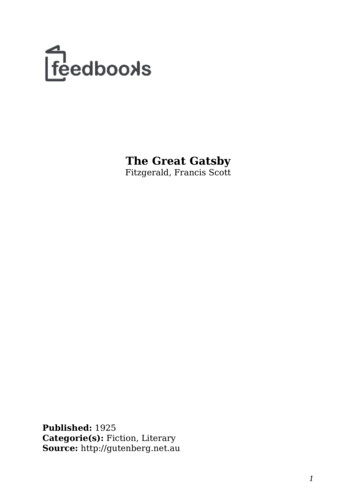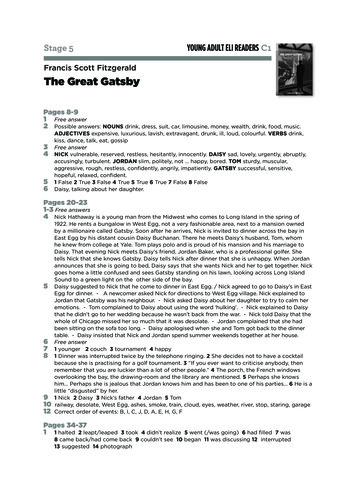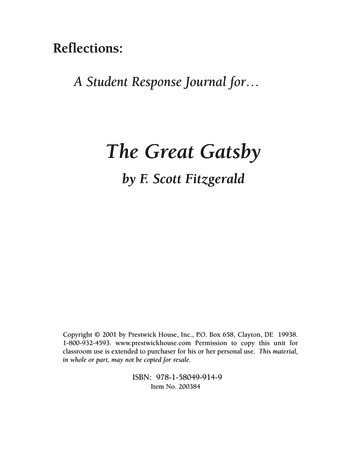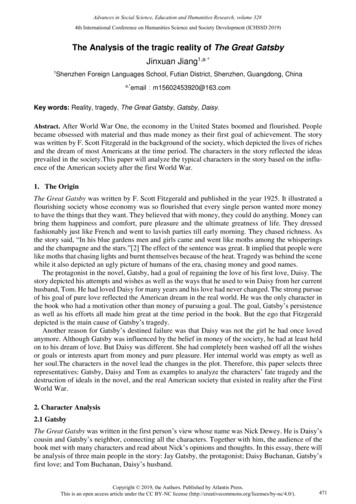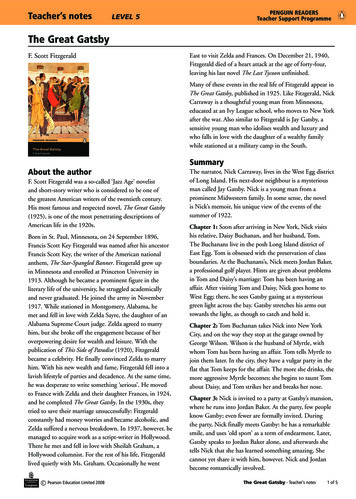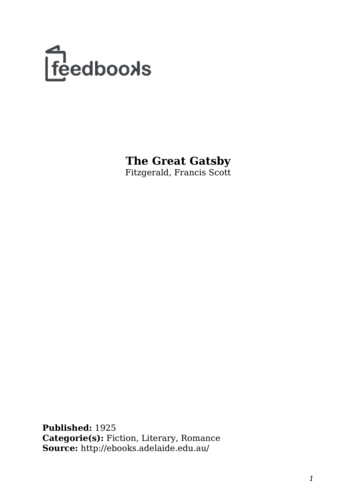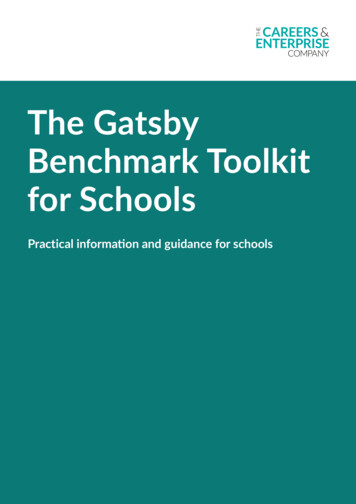
Transcription
The GatsbyBenchmark Toolkitfor SchoolsPractical information and guidance for schools
ContentForewordIThe Careers & Enterprise CompanyIIIntroductionIIIGatsby Benchmark 11Gatsby Benchmark 28Gatsby Benchmark 316Gatsby Benchmark 423Gatsby Benchmark 530Gatsby Benchmark 637Gatsby Benchmark 742Gatsby Benchmark 849Acknowledgements56Reference57
The Gatsby Benchmark Toolkit for SchoolsForewordThe fast-changing world of work puts an ever-greater demand on all of usto support young people in making a successful transition from educationto employment, helping them to identify and choose career opportunitiesthat are right for them.The government’s Careers Strategy, published in 2017, and statutory guidancefor school leaders and school staff, published in 2018, set out the plan forbuilding a high- quality careers system that will help young people to achieve.Thanks to Sir John Holman and The Gatsby Charitable Foundation, we have a clearblueprint of what good careers provision looks like. The eight Gatsby Benchmarksare based on best national and international research and define all the elementsof an excellent careers programme.The Gatsby Benchmarks have now been put at the heart of the Careers Strategy,with an expectation that all schools will begin working toward the Benchmarks.This practical toolkit from The Careers & Enterprise Company focuses on theGatsby Benchmarks. It is designed to help schools identify what ‘good’ lookslike across all eight benchmarks. It includes case studies of best practice aswell as tips and practical suggestions for putting the benchmarks into practice.I hope that the toolkit will assist teachers and Career Leaders in understandinghow the benchmarks can help all young people to reach their full potential.Claudia Harris, CEO,The Careers & Enterprise Companycareersandenterprise.co.ukI
The Gatsby Benchmark Toolkit for Schoolscareersandenterprise.co.ukThe Careers & Enterprise CompanyOur mission is to prepare and inspire young people for thefast-changing world of work.Our role is to link schools and colleges to employers and to helpthem deliver world-class careers support for all young people.How we deliver our role:1. We continue to link schools and colleges to employers and otherexternal careers providers by extending the Enterprise AdviserNetwork across the country and establishing Careers Hubs.2. We provide training and support to Careers Leaders in schoolsand colleges.3. We support implementation of a best practice standard for careerssupport, the Gatsby Benchmarks, with tools and targeted funding.II
The Gatsby Benchmark Toolkit for y Benchmark for Good Careers GuidanceIn 2014, Lord Sainsbury’s Gatsby Charitable Foundation published a report by Professor Sir JohnHolman, Adviser in Education at the Gatsby Charitable Foundation, titled “Good Career Guidance.”The report identified eight benchmarks that are the core dimensions of good careers and enterpriseprovision in schools.The eight benchmarks are:Benchmark 1 – A stable careers programmeBenchmark 2 – Learning from career and labour market informationBenchmark 3 – Addressing the needs of each pupilBenchmark 4 – Linking curriculum learning to careersBenchmark 5 – Encounters with employers and employeesBenchmark 6 – Experiences of workplacesBenchmark 7 – Encounters with further and higher educationBenchmark 8 – Personal guidanceYou can find moreinformation about theGatsby Benchmarks anddownload the originalreport from the GatsbyWebsite here.III
The Gatsby Benchmark Toolkit for SchoolsWhy the Gatsby Benchmarksare importantcareersandenterprise.co.ukHow to read this toolkitThe Gatsby Benchmarks have a key role in:Each benchmark is broken down into the followingkey sections: raising young people’s aspirations and promotingaccess to all career pathways; What good looks like: contains the definition of theindividual benchmark as laid out in The Gatsby; enabling all young people to develop the skills andoutlook they need to achieve career wellbeing,including adaptability and resilience; Benchmarks for Good Career Guidance; underpinning the Department for Education guidanceto schools on meeting their statutory responsibilityfor careers guidance.The Gatsby Benchmark framework was pilotedin the North East and now sits at the heart of thegovernment’s Careers Strategy.Who is the toolkit for?This toolkit has been written for schools.You can access the Colleges and SEND GatsbyBenchmark Toolkits here.IV Why this matters: outlines why this benchmarkshould be a focus and how it contributes tooutstanding careers provision; What this means in practice: guidance and steps thatschools can follow to meet the benchmark; Top tips for schools: actionable tips on how to startto deliver the benchmark; Top tips for employers: actionable tips for youremployer partners in supporting benchmark delivery; Example resources: these are example only and willbe updated annually. Continue to check online.It would also be useful to review this documentalongside The Careers & Enterprise State of the Nationwhich describes the careers and enterprise provisionin secondary schools in England in the academic year2017/18.
The Gatsby Benchmark Toolkit for SchoolsCompass and Tracker digital toolsTo help schools meet the Gatsby Benchmarks, we havedeveloped the Compass evaluation tool. Compassis a fundamental building block of a stable careersprogramme and helps schools to: evaluate their careers activity in around 30 minutes; compare their school to the eight Gatsby Benchmarksfor good career guidance; identify strengths and areas for improvement; get relevant online resources to help them improveon their score; easily share their results with their EnterpriseCoordinator and Adviser, along with other colleagues,or their central Academy team if they choose.careersandenterprise.co.ukKey recommendations to improveschool guidance in your school Careers Leader - Every school should appoint anamed person to the role of Careers Leader to leadthe careers programme and the strategic careers plan. Understand - Read and understand the GatsbyBenchmarks. Guidance – Read and understand Career Strategy(2017) and related Statutory Guidance. Support - Refer to the School Road Map and otherCareers Leader resources to help build a careersprogramme and a strategic careers plan. Training - Complete the free online training:‘Introduction to Careers Leadership’.Once the Compass evaluation has been completed,schools can then use Tracker, a planning tool designedto help: Training - Apply for free face to face training withbursary for Level 6/7 qualification in CareersLeadership. build and manage their annual development plan toimprove benchmark scores; Intent - Audit, map and plan a careers programmewith clear career learning outcomes and create astrategic careers plan for students in all year groupsand for any specific cohorts. easily record events, classes and all careers activitiesin one place; evaluate completed careers activities; access, download and share the careers plan inWord or Excel formal with their Leadership Team,Governors, Enterprise Coordinator, EnterpriseAdviser, Colleagues, Ofsted, etc.Compass is launching in late 2019 and will enableindividual reporting on students’ career activities andis powered by the schools existing MIS system andintegrated with Compass so you can track overallprogress.We have also developed a pilot ‘Find an activityprovider’ directory, which can help schools findprogrammes we fund, generally focused on employerengagements in schools.V Implementation - Ensure careers programme andstrategic careers plan is embedded within andsupports whole school values and priorities and thatit supports and links to other key strategic plans anddepartment development plans. Network - Access our network, which connectsschools and colleges with employers and careersprogramme providers and supports them to worktogether to provide young people with effective andhigh-quality encounters with the world of work.
The Gatsby Benchmark Toolkit for Schools Impact - Consider in advance what impact you wantfrom career programme and strategic career plan andhow impact will be measured (consider destinationdata, exclusion data, attendance and progress, etc). Track - Complete Compass to evaluate your careersprogramme and strategic careers plan.Statutory Requirements:Every school must ensure that there is an opportunityfor a range of education and training providers toaccess all pupils in Year 8 to Year 13 for the purpose ofinforming them about approved technical educationqualifications or apprenticeships (legal duty came intoforce on 2 January 2018).Every school must publish a policy statement settingout their arrangements for provider access and ensurethat it is followed. Example policy statement onprovider access on page 33.Every school must ensure that pupils are provided withindependent careers guidance from Year 8 to Year 13.(legal duty came into force in September 2012).The appointment of a Careers LeaderFrom September 2018, schools are expected to haveappointed a dedicated Careers Leader to lead a careersprogramme underpinned by the Gatsby Benchmarks.The statutory guidance requires SLT, Headteacherand the Governing Body to give “explicit backing” tothe Careers Leader to ensure there is strong strategicleadership to develop a progressive and impactfulcareers programme.Further information about the role of the CareersLeader can be found here.careersandenterprise.co.ukVICompliance with the Baker ClauseFrom January 2018, a new duty to provideopportunities for “a range of technical education andapprenticeships to access pupils and inform themabout technical qualifications and apprenticeships”was established. Every school is expected to publisha provider access policy which sets out theirarrangements for education and training provideraccess to pupils and the access policy should be signedoff in agreement with the governing board.
The Gatsby Benchmark Toolkit for Schoolscareersandenterprise.co.uk1Gatsby Benchmark 1A stable careers programmeWhat goo d looks likeEvery school should have an embeddedprogramme of career education and guidancethat is known and understood by students,parents, teachers, governors and employers. Every school should have a stable, structuredcareers programme that has the explicitbacking of the senior management team andan appropriately trained person responsiblefor it. The careers programme should be publishedon the school’s website so students, parents,teachers and employers can access andunderstand it. The programme should be regularly evaluatedwith feedback from students, parents,teachers and employers as part of theevaluation process. Schools must give providers of technicaleducation and apprenticeships theopportunity to talk to all pupils.Why this matters This benchmark provides a foundation for the otherseven benchmarks. A stable careers programme to prepare young peoplefor the opportunities, responsibilities and experiencesof later life is a core statutory responsibility forschools. Inspiring careers and enterprise activities in a stablecareers programme improves motivation, attendanceand attainment. New research entitled ‘Motivated toachieve’ shows that participation in career talks withvolunteers from the world of work can change theattitudes of Key Stage four (14-16 years old) pupils totheir education. A stable careers programme enables youngpeople to make well-informed decisions abouteducation, training, apprenticeship and employmentopportunities. It also helps them cope withchallenging labour market conditions. We know thatyoung people are three times more likely than adultsto be unemployed. Delivering social mobility and justice relies onopening doors for all young people. The governmenthas endorsed the fact that “great careers guidanceprovides the first rung on the ladder of opportunity,helping everyone to achieve their full potential”(DfE, 2017, p. 3). A stable careers programme can play a part inpromoting social mobility for the benefit of youngpeople, their families and wider society. From recent research, 94% of Careers Leaders believethat the Gatsby Benchmarks have helped improvecareers guidance.
The Gatsby Benchmark Toolkit for Schoolscareersandenterprise.co.uk2What this means in practice The careers programme has strong backing fromthe Headteacher or Principal, senior leaders andGoverning Body. Through the development of astrategic careers plan, it needs to be embedded.This means the programme can continue to bedeveloped to meet the needs of students. It is notentirely dependent on the goodwill of individualsor vulnerable to competing education priorities. The careers programme is coordinated and led by anappropriately trained and supported Careers Leader.A Careers Leader is responsible and accountable forthe delivery of their allocated school’s programme ofcareers advice and guidance within a strategic careersplan. It is a senior role that requires the person doingit to have a clear overview of the school’s careersprovision and to make sure that the school meetsthe Gatsby Benchmarks by the end of 2020. See‘Understanding the role of the Careers Leader’ forfull details. Students, parents, teachers and employers knowwhat is in the careers programme. The careersprogramme is set out clearly on the school’s websiteand promoted through the school’s social mediaaccounts and newsletters and local media outlets.Students should discuss the careers programme inthe school council, where one exists, and parentsshould know what to expect in the meetings arrangedfor them throughout the year. Messages for teachersare reinforced through the staff handbook, meetingsand curriculum guidelines. Employers invited toparticipate in the careers programme know clearlywhat to expect, how their contributions fit in andhow they will benefit. A plan for how the careers programme will beimplemented is included in an annual careersplan that includes priorities from the overall schooldevelopment plan. This makes it easier to evaluatethe achievements of the careers programme at theend of each year. Students, parents, teachers and employers provideregular and systematic evaluative feedback on theirparticipation in activities via questionnaires, surveysand focus groups. Key stakeholders are also involvedin overall evaluation of the careers programme andstrategic careers plan. This feedback is then used toinform decisions about the future development of thecareers programme and feeds into the whole-schoolprocess of evaluation.
The Gatsby Benchmark Toolkit for Schoolscareersandenterprise.co.uk3Top tips for schoolsPlanDeliver Encourage all relevant staff and stakeholders tocomplete the free online training ‘UnderstandingCareer Leadership’ modules via The Careers &Enterprise Company’s website. Publish your careers programme on your website andcommit to making all stakeholders aware of it andkeeping it up to date. For more intensive Careers Leader professionaldevelopment, sign up to fully funded place on aCareers Leader training course, with a range of nonaccredited and Level 6/7 accredited options. Join the Enterprise Adviser Network and gain accessto an Enterprise Coordinator and an EnterpriseAdviser. Read The Careers & Enterprise Company’spublication: Understanding the Role of CareersLeader. Develop a careers programme based on identifiedand agreed career learning outcomes. Considerusing the CDI Framework to help shape your CareerLearning Outcomes within your programme. Work with SLT, governors and Enterprise Adviser todevelop a strategic careers plan showing how you willimplement the programme and how you will measurethe impact of the programme. Understand and plan for how careers guidancefeatures in the Ofsted Education InspectionFramework and in the Ofsted School InspectionHandbook/Oftsed Further Education and SkillsInspection Handbook. Promote the importance of the careers programme tostudents, parents and employers so that they knowwhat to expect and how they can contribute to itssuccess. When planning staff CPD make sure that staff areaware of Careers Strategy and the benchmarks andwhat that looks like for your school. Highlight thatcareers guidance is a shared responsibility.Measure Complete Compass to evaluate your currentprovision. Evidence suggests that progress isenhanced when schools complete Compass morethan once as part of a regular process of selfassessment. Undertake regular evaluation of the careersprogramme with a clear intended purpose, forexample, reports for the senior leadership team andthe Governing Body should be used to inform futuredecisions about the careers programme. Consider completing the Quality in Careers StandardCEAIG Quality Award.
The Gatsby Benchmark Toolkit for Schoolscareersandenterprise.co.ukTop tips for employersUseful resources If you are an Enterprise Adviser, review the intentand specific career learning outcomes within theschool’s careers programme. Support the CareersLeader in building a strategic careers plan to beable to implement ad measure the impact of thecareers programme.Practical guides to developing a stable careersprogramme: Ask the school for their careers programme andsee where your expertise will count most. Be a critical friend – support and challenge theschool to develop a stable careers programme. Be prepared to build a long-term relationship andto contribute to all aspects of school life. Make sure your staff are briefed before taking partin activities. Contribute to the school’s evaluation and act onfeedback to do things differently or better nexttime. Help schools develop a programme that takes intoaccount the trends in your business, your sectorand the wider economy. Use your networks to encourage others tocontribute to the careers programme and to takeon key supporting roles. Review all existing employer engagement andmake sure that it has maximum impact andstreamline where appropriate. Department for Education Careers Strategy, 2017 Department for Education careers guidance andaccess for education and training providers Statutoryguidance for governing bodies, school leaders andschool staff, 2018 Gatsby Good Career Guidance Understanding the Role of Careers Leader (School) Understanding the Role of Careers Leader (College) Link to free online course supporting CareersLeadership CDI Careers Framework 2018 Ofsted Education Inspection Framework andHandbooks4
The Gatsby Benchmark Toolkit for Schoolscareersandenterprise.co.ukYour careers programme will inform everyone (students, teachers,parents and employers) what each student can expect in terms oftheir careers learning, in each year at your school.Your strategic careers plan is a working document, to inspire andinform all stakeholders of your vision for the future so that theybuy-in and support you to achieve everything that is set out in it.The following gives a brief overview of what is covered in moredepth and with more support in the free online training modulesand in the funded face to face Careers Leader Training.5
The Gatsby Benchmark Toolkit for Schoolscareersandenterprise.co.uk6Building a stable careers programmePlanMeasure Identify and record your intended career learningoutcomes for your careers programme. Use CDIFramework and Skills Builder to set career learningoutcomes. Make sure your careers programme is progressive andhas a logical flow in terms of identified career learningoutcomes and outputs for each key stage and specificcohorts. Engage with senior leadership colleagues, LinkGovernor and your Enterprise Adviser to reviewcareer learning outcomes. Complete ‘Entitlement Statements’ for all year groupsso that all students and parents can see, for eachyear, what they will have experienced and completed,e.g. ‘By the end of Year 7, I will have.’ . Work with teaching and learning, PSHE, literacyleads, etc. to make sure that your careers programmeis aligned to their programmes and vision. Identify staff CPD and parental engagement that willsupport delivery of your careers programme. Ensure that your careers programme is written downand has the approval of SLT and governors and that ithas sufficient resource to be delivered.Deliver Work with colleagues to audit current provisionand champion where career learning outcomes arealready being delivered. Consider where and how to deliver interventions tocover gaps in your careers programme. Work with colleagues to agree how careersprogramme will be delivered through assemblies,tutorials, drop down days, activity days andcurriculum time. Ensure that your careers programme is published onthe school’s website. Include information on website specifically forstudents, teachers, employers and parents/carers. Complete Compass self-evaluation tool to identifygaps in the programme to be addressed in yourcareers programme and/or strategic careers plan. Plan regular monitoring of the careers programmeusing data tracking and stakeholder voice. Work with students, staff and parents to get recordedfeedback on a regular basis to inform future planningand delivery of careers programme.
The Gatsby Benchmark Toolkit for Schoolscareersandenterprise.co.uk7Building a strategic careers planPlanWhen building a strategic careers plan, work withcolleagues from senior leadership team, governors andyour Enterprise Adviser to consider the following*: Vision; Current provision; Key strategic objectives linked to school priorities; Action plan to achieve objectives.In practice:Lilian Baylis Technology, an 11-19 school in SouthEast London, has created a programme that aimsto transform the life chances of all students bysupporting the development of healthy, confidentand independent young adults. The Governing Bodysupports the programme through a designated LinkGovernor and the commitment of the senior leadershipteam is reflected in the school development plan. Theschool’s careers plan clearly sets out the roles of keystaff involved in planning and delivery of the careersprogramme and strategic careers plan. The programmeincludes activities for all students from Years 7 to 13that are delivered through:For step by step support and guidance with buildinga strategic careers plan, complete The Careers &Enterprise Company’s free online training modules andregister for funded face to face Careers Leader trainingto support in building a stable careers programme and astrategic careers plan. assemblies;Deliver the personal, social and health education programme(PSHE); Communicate your vision and strategic careersplan to all stakeholders. employer encounters;*Measure Share successes from strategic careers plan aroundprogress against benchmarks and key strategicobjectives. Work with senior leaders, governors and EnterpriseAdviser to review strategic action plan to informfuture planning and delivery. enrichment activities; tutor time; workplace experiences.The Enterprise Adviser acts as a critical friend and ishelping the ongoing development of a programmethat has a high impact on students. The school hascompleted the Compass evaluation and is using itto drive improvement. They have contracts with anexternal guidance provider to offer information, adviceand guidance. They have also completed the KirklandRowell survey with parents, who rated the school asoutstanding for: developing young people’s confidence; explaining how to help their children; providing post-16 careers advice.
The Gatsby Benchmark Toolkit for Schoolscareersandenterprise.co.uk8Gatsby Benchmark 2Learning from career and labour market informationWhat goo d looks likeAll students and parents should have accessto high-quality information about future studyoptions and labour market opportunities. Theywill need the support of an informed adviser tomake best use of available information. By the age of 14, all students should haveaccessed and used information about careerpaths and the labour market to inform theirown decisions on study options. Parents should be encouraged to access anduse information about labour markets andfuture study options to support their children.Career and Labour Market Information(LMI) includes information on: skills, career pathways and progression routes in thelocal labour market; job applications and interviews; educational institutions, courses, qualifications, entryrequirements and costs; professional bodies; employment sectors, employers, jobs, salaries andemployment trends; jobs, training and apprenticeships; job demands and working life; financial planning.
The Gatsby Benchmark Toolkit for Schoolscareersandenterprise.co.uk9What this means in practice Students have access to accurate and up-todate information, which plays a key role in raisingaspirations and promoting social mobility. Thisinformation challenges stereotypes with regionaland national LMI and support from Local EnterprisePartnerships (LEPs). Your school arranges for students to gain informationfirst-hand through encounters with employers andexperiences of workplaces. Staff organise followup activities in the classroom to help students topersonalise and maximise the benefits of theseencounters. Students are taught how to find and processinformation from Year 7 onwards. They use objectiveinformation about the local and national labourmarket to make decisions that improve their careersand transitions into work. Local Enterprise Partnerships produce local labourmarket information to help students, parents andstaff understand the changing labour market intheir area. These resources are actively promotedby schools on their websites and at events, such asparents’ evenings. Information is adapted to meet the needs of differentlearners. Special schools, for example, make gooduse of Makaton signs and symbols to supportunderstanding of careers and employability forstudents with severe learning and communicationdifficulties. The careers information area is attractive, highlyvisible and contains carefully-selected resourcesthat meet the needs of different groups. The areashould be properly maintained, well-used andinclude a mix of printed information (careers books,posters, prospectuses), online resources (dedicatedcareers pages on the website and/or Virtual LearningEnvironment VLE) and in-house information (optionsbooklets, alumni profiles, projects) to help studentsunderstand the range of different opportunities. Your school tracks destination data to inform careersprogramme and strategic careers plan development.Why this matters Access to up-to-date career and labour marketinformation is important for social mobility.Information about pay, numbers of vacancies andalumni’s successful transitions helps to connectstudents to a different future. Providing detailed information about progressionroutes, relevant courses and employers and usefulnetworks strengthens their capacity to makeeffective choices and transitions. Providing detailed information about progressionroutes, relevant courses and employers and usefulnetworks strengthens their capacity to makeeffective choices and transitions.
The Gatsby Benchmark Toolkit for Schoolscareersandenterprise.co.uk10Top tips for schoolsPlanMeasure Make sure you are compliant with statutory guidanceand review your website and resources to ensure youcover all routes and engage the interests of students. Plan regular monitoring of the programme using datatracking and stakeholder voice. Check that you are making good use of resourcesavailable through your Local Enterprise Partnership,via the Enterprise Adviser Network.Deliver Start early so that young people and their parentshave a good amount of time to explore opportunitiesand build full and realistic pictures of the job market. Ensure events and parents’ evenings explain andpromote the full range of opportunities in animpartial way, including emerging technical levels.This should also include information about localUniversity Technical Colleges and studio schools tosupport decisions at the 14 level. Draw on JobCentre Plus schools advisers to comein to talk to pupils, parents and staff about local LMIand apprenticeships. Your Enterprise Adviser andEnterprise Coordinator will provide local contactdetails. Train older students to support younger colleagues tomake use of key careers information resources. Make use of a wide range of media to encouragestudents in their career exploration including socialmedia, posters, websites and physical resources. Develop a careers assembly plan that identifiescareers information topics appropriate for each yeargroup. Work with students, staff and parents to get recordedfeedback on a regular basis to inform future planningand delivery of careers programme.
The Gatsby Benchmark Toolkit for Schoolscareersandenterprise.co.uk11Top tips for employers Provide references to good sources of information aspart of employer engagement events. Encourage students to undertake follow-up researchso that they can find out more and start to put plansinto action. Provide practical examples of how different subjectsare used within the workplace so that students valuethe skills and knowledge they are developing atschool. Illustrate your talks with film clips or job profiles fromfree careers resources, such as I Could or the NationalCareers Service. Bring talks to life with concrete case studies thatshow diverse pathways and job opportunities inyour organisation. You should also provide yourorganisation’s websites with details of entryrequirements. Share your insights into trends in the labour market aspart of your contribution but encourage students todo their own research too. Contribute to the training of teachers and CareersAdvisers about changes in the labour market toensure those working directly with students on a dayto-day basis are up-to-date. Listen to
Understand - Read and understand the Gatsby Benchmarks. Guidance - Read and understand Career Strategy (2017) and related Statutory Guidance. Support - Refer to the School Road Map and other Careers Leader resources to help build a careers programme and a strategic careers plan. Training - Complete the free online training:



